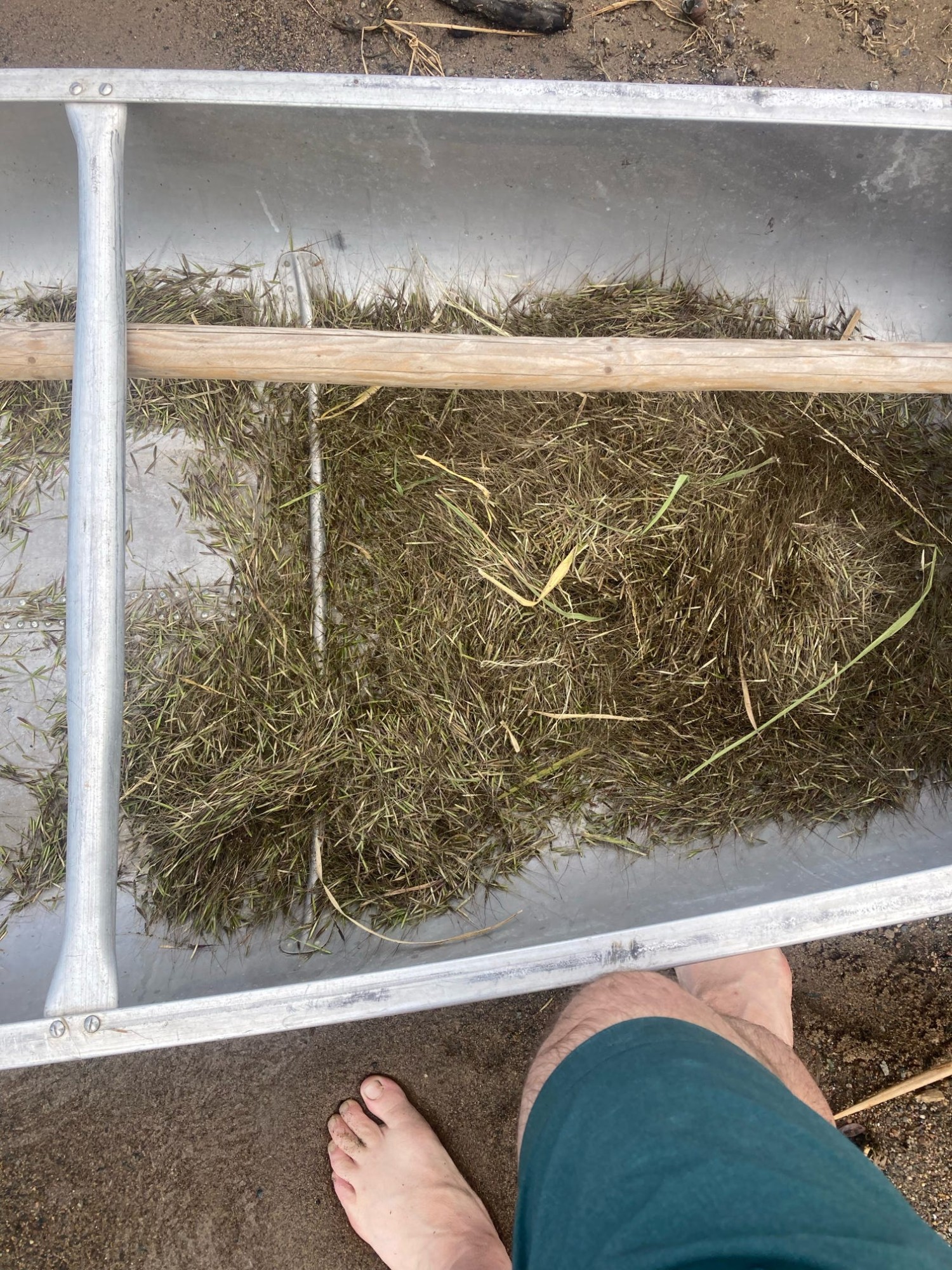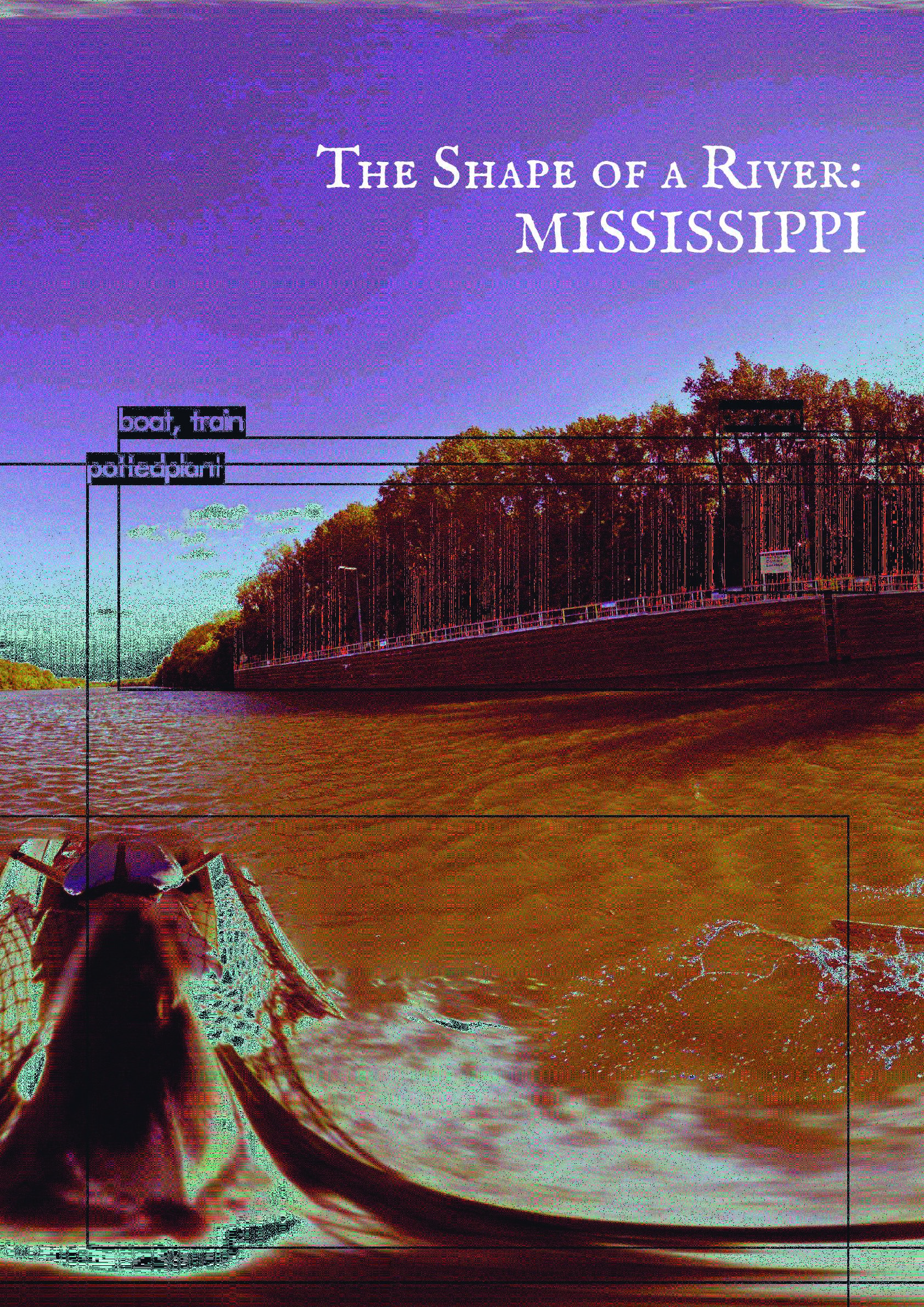This recipe is a part of the Mississippi Mud Book of Recipes.
Ricing began the night before we went out on the lake. We sat around the second fire, carving wood knockers from cedar branches that Justin had cut earlier that day. He sat across the fire from me, not speaking except when asked for advice, when he would say a brief, assuring remark about how good our knockers looked so far. There wasn't much instruction except watching him and others around us who had started before we did. We borrowed knives from each other and from Justin, swatted mosquitoes and talked. He might comment on a particularly bent branch and we would laugh, or we might listen to a hilariously bawdy story told by his Aunt Betsy, as she sat on her walker near the fire. “Didn't you show them how to do this?” She would ask Justin, who would glance around at us and say, “looks like they've got it figured out for themselves!” with a knowing smile.
Once the strong wood knockers were smooth and balanced in our hands, we placed them all in a basket for everyone to share and use. Everything made at the Water Protector Welcome Center in Northern Minnesota was for everyone to share and use. The place was run by two principles: "Be a good relative" and "Many hands make easy work"–it did not need to be spoken, it was enough to know the history of the place as a shelter for pipeline fighters, land stewards, and water lovers.

The process of gathering rice is ceremony, and acknowledging these principles is the first precept. On the morning we went to the lake, we gathered on the shore by the Big Sandy Lake's boat ramp with tobacco in our left hands and gave gratitude for the land, and the innumerable relatives that brought us to this day and this opportunity to harvest the rice to eat. Aileen, Justin's sister, said a quiet blessing in Lakota and we gave our tobacco to the lake. Rory, Justin's brother, told me at one point "you can tell the story of the Dakota people simply through telling stories of their food." The ceremony looks forward and backwards. The collection and harvest of food is both a means for remembrance and self-care and the beginning of a new time for creation and memory making.
Ricing works this way: two people are in a canoe, aluminum in our case, one standing with a push pole and one sitting with a knocker in each hand. I held the push pole–and though we started early in the morning, the sun baked my flesh and my tendons ached about a half-hour into the two and a half hour process. The push pole was a 20 foot long maple wood trunk, whittled down to a smooth pole about five inches in diameter. The pole makes the canoe easier to maneuver in the dense rice patties. I would get us stuck above the water on stalks of purple rice as my sweat dripped into my eyes and blinded me. This would require the even more physically challenging of going in reverse and finding a more passable route.
The knocker (the person holding the knockers) sits in the belly of the canoe and pulls the stalks into the boat, beating them with the other knocker to loosen the rice. It is also hard work, and the process often leaves the canoe full of spiders and earwigs amongst the hair-like rice casings. We collected about 10 pounds as a group in two and a half hours, a small amount compared to how much our experienced friends from the Welcome Center had gotten the day before, but not meager.

Back at camp, we dug a hole for the fire and began to parch, a multiple-day process of mixing the rice in a large metal cauldron over a hot flame. This hardens the rice, separating it from its casings and lightly toasting the grain. After that came dancing on the rice, separating the black and white grains from the now parched brown casings. It was described by some of the people there as processing the rice, but it's a different form of processing grain than that known by American flour mills and sugar refineries.
I have Native American heritage through my mother and my grandfather. My grandfather was of the Mimbrenos band of the Chiricahua Apache in what is now southern New Mexico, and my mother and her side of the family were largely the inspiration for this foodways project. They are all cooks or lovers of good food in some capacity, and meals at our house are binding for our family. Meals are feasts with us, where everyone is responsible for bringing something and critiquing everything. Chef and food writer Michael W. Twitty writes "in memory there is resurrection, and thus the end goal of my cooking is just that–resurrection." Twitty writes of his memory in relation to a cooking life that is dependent on the importance and necessity of cooking in the lives of enslaved people and their descendents, but it speaks to an intrinsic remembering that lies in food, cooking, and that loaded term "foodways."
Foodways describes the strength and cunning of Indigenous and Black people in preserving and revitalizing their cultural knowledge. A paleobotanist at Cahokia, Illinois may use "foodways" to describe an antiquated process for harvesting and preparing ancient grains or beans. Ultimately process and memory cannot be separated and in memory lies a unique knowledge of self, place, and ancestry. My family gathers in the week between Christmas and New Years to make tamales, and the process of making the chile and masa is a solemn and celebratory ceremony of my grandparents and a tradition that has largely been lost to time and systemic erasure.
The reason why I mention this ceremony and the indistinguishable strength of process, Indigeneity and home is because rice–the staple of this dish–cannot be confined to a single family or culture. Like many things that thrive in water, defining it takes more than just encountering it in a few places. As Twitty writes, "Rice connects me to every other person, southern and global, who is nourished by rice traditions and customs." We witnessed unfathomable acres of rice grown over the levee in Arkansas by white farmers. When we visited Whitney Plantation, Dr. Ibrahima Seck spoke of rice's influence in southern cuisine. Jambalaya, he said, is the way rice is traditionally prepared by the Jolof people in Senegal. Only two variations of rice have ever been domesticated, yet other varieties of rice exist as staples in Indigenous communities worldwide. Rice is to culture as process is to indigeneity, a way of exploring self and people as nuance and indigeneity are largely becoming more difficult things to practice and rediscover.
The Lakota people (and most all native folk) live with the precept of being a good relative. This was not lost on us visitors. I said that the ricing ceremony began the night before we went out on the lake, but it began long before that. It began when the rice took root in the muddy bottom of a river or lake. It began when that water began flowing, or when sediment began to form. Defining beginnings and rice is a vague, muddy task, as are defining most things that live alongside and in water. Where we end and our relatives begin is equally as challenging to define, especially along the banks of a river.
The evening we ate this three sisters soup was the end of our first rainy day on the river. We built our kitchen on the muddy bank as the torrential day turned into a misty evening. The sky broke through the dense floodplain forest as an apology towards our silent, damp-clothed bodies–John worked alone in the small patch of bank that could support his weight, and the boats sank into the earth only a few feet from his heels. We collected wild mint. No tows passed, and the river introduced its wilderness for the first time in our young trip. Toni Morrison wrote: "'Floods' is the word they use, but in fact the river is not flooding; it is remembering." We had encountered water above and below us, a subtle but bone-chilling deluge. We were beginning to get to know the fertile valley that produced and sustained the three sisters, and the river's muddy, unseen ceremonial process.
John Kim's Three Sisters Soup
Ingredients:
Squash
Wild Rice
Chicken Bouillon
Onion
Fennel Seed
Paprika
White Vinegar
Scarlet Runner Beans
Wild Mint (as a garnish)
Heat bouillon in a pot with oil. Saute onions. Deglaze pot with water and start simmering broth, adding squash, wild rice, and soaked beans. Allow to simmer, adding each ingredient when circumstance calls for it, finishing with white vinegar splashes. Best served after a long, cold day and with available ingredients.
Twitty, M. (2020). The cooking gene: A journey through African American culinary history in the Old South. Amistad, an imprint of HarperCollinsPublishers.

